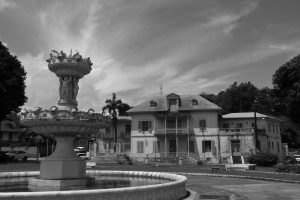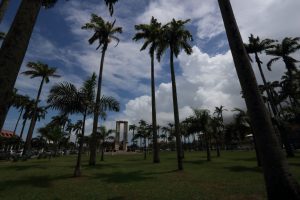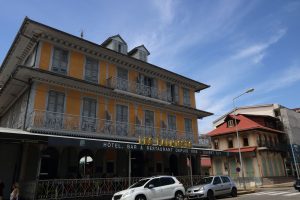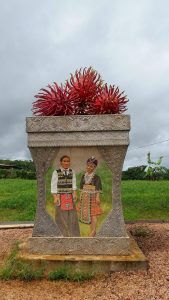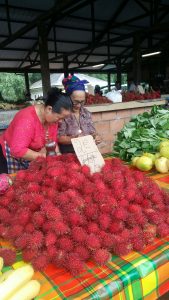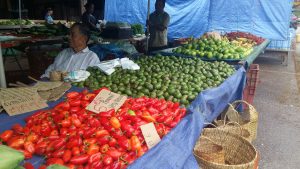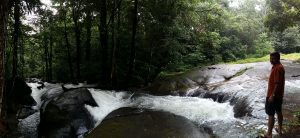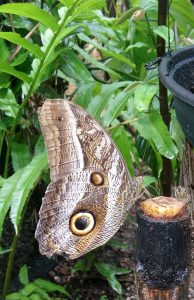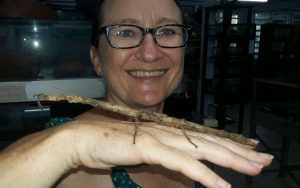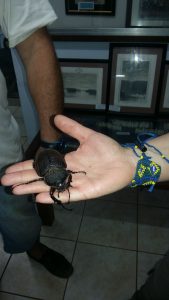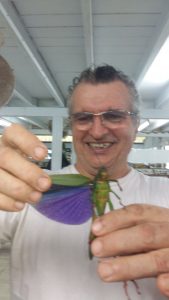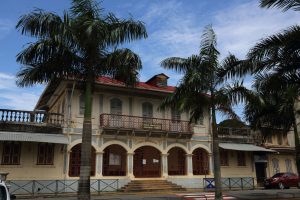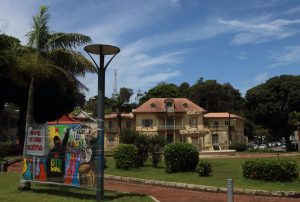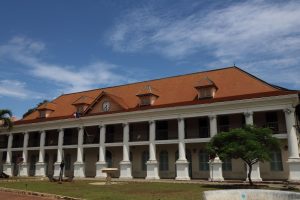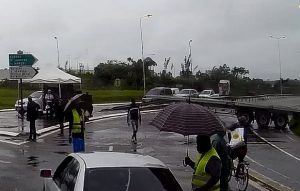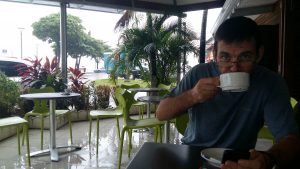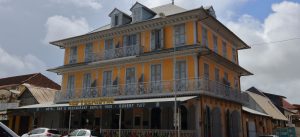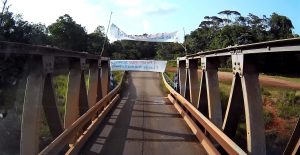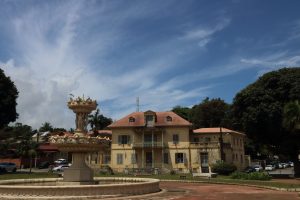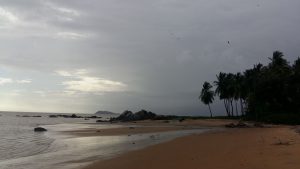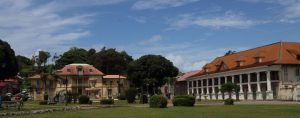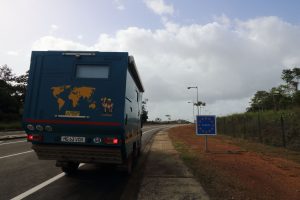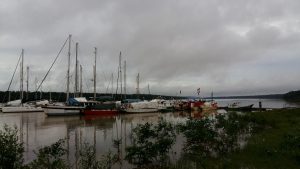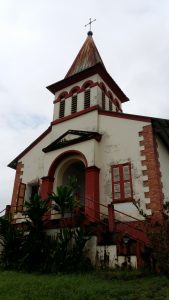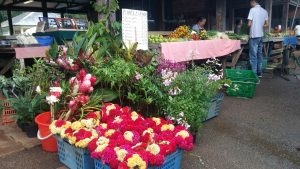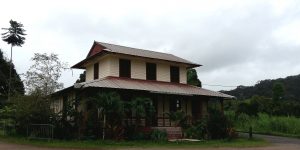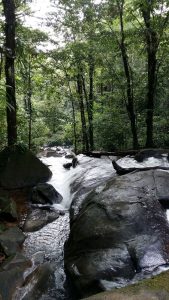Just over the bridge from Brazil Amazon and… politics! Overlanders are always best advised to avoid national politics as they travel, but sometimes things just jump in your face. French Guiana is an overseas department of mainland France. It’s officially part of the EU, it has the Euro currency and, we find out to our cost, the people have the same French propensity for road blockades and labour strikes when they feel hard done-by! 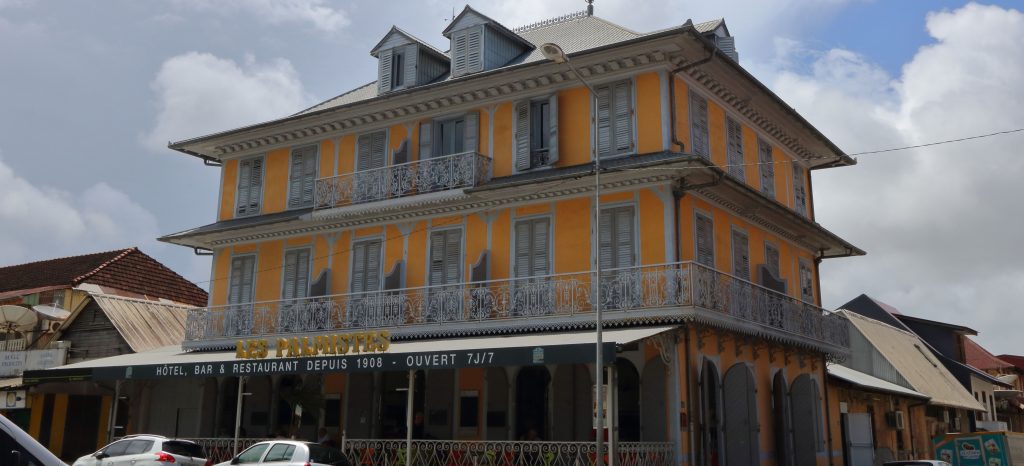
Bridge to Europe
For the those who missed our last blog (shame on you!) we’ll recap the background and how we find ourselves taking an auspicious place in history 🙂
Until two or three weeks ago we had expected our border-crossing from Brazil to French Guiana to be an expensive hurdle. The bridge over the border Rio Oiapoque was completed some years ago but unfortunately someone forgot to do the ribbon-cutting ceremony-thing and it went unopened. For years, instead of using the new multi-million-euro bridge, all crossings were by a local ferry carrier who charged a ludicrous US$250 for a 5 minute crossing!! This price could be shared if you could find anyone else wanting to do the trip… yeah… good luck with that! Anyway… just a few weeks ago, they found someone to cut the ribbon and the bridge finally opened just as we were heading across northern Brazil towards it!!! As we heard the news, we couldn’t believe our luck… no crazy ferry fee!
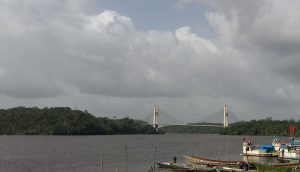 As we approach the river town of Oiapoque we haven’t had internet or news access for several days and we’re keeping our fingers crossed on two points: (a) that the bridge is still open and wasn’t a flash-in-the-pan event; and (b) that the strikes and road blockades in French Guiana have been resolved by a recent Ministerial visit from Paris. Well… we have a 50% success rate! The bridge opening has been a success, but the French Ministerial visit not so much. The locals are still unhappy bunnies and feel they’re getting a raw deal from mainland France, so the strikes and road blockades continue.
As we approach the river town of Oiapoque we haven’t had internet or news access for several days and we’re keeping our fingers crossed on two points: (a) that the bridge is still open and wasn’t a flash-in-the-pan event; and (b) that the strikes and road blockades in French Guiana have been resolved by a recent Ministerial visit from Paris. Well… we have a 50% success rate! The bridge opening has been a success, but the French Ministerial visit not so much. The locals are still unhappy bunnies and feel they’re getting a raw deal from mainland France, so the strikes and road blockades continue.
As we drive over the river into France we’re welcomed with a ‘Bonjour, bienvenu a France’ from some smiling Gendarme. Blimey… this friendly welcome to Brits will never catch-on with their colleagues at Calais! One of the officers speaks good English and is excited to announce that we are the first Britons ever to enter France from Brazil by road. Oooh… a claim to fame! It’s all totally coincidental of course and we don’t expect to see our names on the Queen’s Birthday Honours List anytime soon 🙂 but it’s nice to be a trivial pioneer ‘First Briton to…’
Back to more practical things… in a brilliant ‘Listen carefully, I shall say this only once’ (yes, that 1980s UK tv series ‘Allo, allo’) accent, the helpful officer explains that unfortunately French Guiana isn’t currently showing its best side; there are strikes and road blocks across the country. He stresses that these are all peaceful and it’s perfectly safe, but we’ll find it difficult to travel around the country. Some of the road-blocks are lifted at night, so that is the best time to drive anywhere. Okay… we can live with that. They won’t hold out this palaver for long will they? If there are hold-ups in the road, we can just climb in the back and make a cup of tea while we wait.
The conversation then moves on to the matter of our vehicle insurance, or more accurately, our lack of. We want to buy a policy at the border (common practice at most overland borders) but after much discussion amongst the gathered officers, it seems they can’t sell a policy for an EU registered vehicle. Skipping past the tedium, the upshot is that it’s illegal to drive on the roads in France without insurance, they can’t sell us insurance, ergo… they can’t let Cuthbert into the country! It’s possible that we’ll be able to buy cover in the capital Cayenne, but that’s 200km away. The friendly, English speaking officer takes pity on our plight and goes off to speak to the boss. Eventually it is agreed that we can enter on strict condition that we drive straight to Cayenne to buy a policy. The journey will be slow due to the protests, but we should be able to make it once the blockades open for the night.
Road-block central
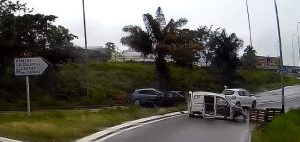 So off we set to tackle the road-blocks. It’s been a looong day of dull driving through northern Brazil but if we can’t drive in day-light tomorrow, we need to keep going to reach Cayenne tonight. The good news is that: (i) the road quality is good, it’s ages since we have a driven a 200km stretch of road with no potholes; and (ii) the rural road-blocks are rather half-hearted. At a couple of them we’re waved through with a smile. At another we have to get out to untie and move the banners whilst the ‘protesters’ wave to us from paddling in the river nearby (true dedication to their cause 🙂 ). But eventually we reach the more serious guys on the outskirts of Cayenne.
So off we set to tackle the road-blocks. It’s been a looong day of dull driving through northern Brazil but if we can’t drive in day-light tomorrow, we need to keep going to reach Cayenne tonight. The good news is that: (i) the road quality is good, it’s ages since we have a driven a 200km stretch of road with no potholes; and (ii) the rural road-blocks are rather half-hearted. At a couple of them we’re waved through with a smile. At another we have to get out to untie and move the banners whilst the ‘protesters’ wave to us from paddling in the river nearby (true dedication to their cause 🙂 ). But eventually we reach the more serious guys on the outskirts of Cayenne.
At the city road-blocks there are far more protesters and they’ve deployed burned-out cars or huge trucks across the road at key junctions. They’ve clearly been here a while and have settled down to enjoy their stay: there are smart-looking marquees, music systems playing loudly, BBQs blazing and those not manning the barriers are relaxing at the side of the road in deck-chairs with beers in hand. No wonder they’re not rushing back to work! We navigate through the chicanes at a couple of blocks where they let us pass, then just as we are a couple of kilometres from our planned park-up spot, we reach a total no-go blockade. Even at night they’re not going to let us through this one. Arrrrgh!! Frustrating as we’re so close! The more central we get into town, the more frequent the blockades become. We keep trying and turning around and trying another way… thank goodness for GPS sat-nav! Eventually we reach a quiet spot and settle down for the night, shattered but pleased to be here.
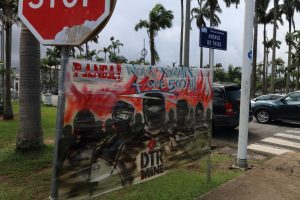 Over the next few days we find the road blocks around the Cayenne area are varied in determination during the day. At some of the town-blockades a determined (or stupid?) driver could probably push through. Hmmm… none of the locals are doing this; best not to risk a diplomatic incident, eh? At some of the blocks the protesters have deployed planks of wood with huge upward facing nails across the road, which would really spoil your day.
Over the next few days we find the road blocks around the Cayenne area are varied in determination during the day. At some of the town-blockades a determined (or stupid?) driver could probably push through. Hmmm… none of the locals are doing this; best not to risk a diplomatic incident, eh? At some of the blocks the protesters have deployed planks of wood with huge upward facing nails across the road, which would really spoil your day.
Insurance issues
Our first day in Cayenne is a sunny morning in town but it all seems disarmingly quiet. Not much traffic, shops mostly closed and the insurance office is locked-up too. Down the street is the Suriname Consulate where we’ll need to get our visas for the next country, also closed. In my barely intelligible school-girl French (I’m sure that one day “My fountain pen is on the table” will come in handy) I manage to ask a chap on the street when things might open. His response is a typical Gallic ‘Who knows?’ style shrug. Maybe tomorrow… maybe not! Okay… we’ll find a nice spot to park-up and wait. We’d really like to get insurance so that we have complied with the conditions of our entry to the country, but if we can’t get this, at the very least we need the Suriname visa to be able to move on.
On a positive note… we take an immediate shine to Cayenne. We’re not generally townie types, but Cayenne has a certain ‘je ne sais quoi’ and we can happily spend some time here (quite fortunate really, given the situation!) Prevailing hassles aside, Cayenne is a charming town with a pleasant mix of well-preserved colonial history, modern infrastructure and nice wide green areas. There are some reasonable beaches nearby, but the sea is all a bit browny-churned-up from the (relatively) nearby Amazon out-flow and apparently there’s a shark risk… so it’s not hugely inviting for a swim! Like any town Cayenne has its ‘less savoury’ areas, but it has some lovely residential suburbs down the coast to the south of town. Restaurants and street cafes are mostly open, but not many shops. After our fairly rapid pace through Brazil, a bit of slow-time in Cayenne is very welcome.

After four days, the insurance office (but not much else) opens for business. Initially they say they can’t help us as ‘motorhome’ isn’t a category on their system, but eventually they find a way to issue a truck policy to us. Cover is only for 15 days and it’s expensive, but at least we’re legal on the road and have met our conditions for entry to the country. French Guiana is less than 500km across and doesn’t have an abundance of tourist attractions, so 15 days would generally be enough to see what there is to see. But we’re rather more tied to the opening of the Suriname Consulate so that we can get our ‘tourist card’ visas to move on to the next country. If we have to go back to Brazil, there is no land-route other than to retrace our steps all the way back to the Amazon Delta and all the way back to Belem on the barge!
Space Race
Now that we have our insurance, our stay in French Guiana has turned into our personal Space Race! One of the things we really wanted to see here is a rocket launch from the European Space Centre in Kourou. Typically, they fire one or two launches per month and the next is due to send a Brazilian and a South Korean satellite into orbit. But this high-profile stuff is a natural target for the protesters who seem to be successfully crippling the space programme. On our day five in the country, news comes from Paris of an aid package for French Guiana. Obviously it’s not as much as the protesters wanted (€1bn is on the table compared to the demanded €2.5bn – didn’t Mick once say… ‘You can’t always get what you want’ ?) but is it sufficient to lift the blockade? Well… it does get the immediate blockade outside the Space Centre lifted, but not the blockades and strikes around the rest of the country. Understandably, the Space Centre isn’t publicising details of the damage to their programme, so they now have us on tenterhooks, waiting to see when Ariane mission VA236 will blast-off.
Little Laos
French Guiana isn’t over-endowed with obvious tourist attractions; it isn’t even over-endowed with roads! There is a good quality but very small road network along the coast from east to west borders, but most of the country consists of dense and totally inaccessible Amazon jungle. Nevertheless, there are some lovely places to visit and we spend some days driving a short distance into to the jungle to visit trails, waterfalls and small villages.
Around 50 km from Cayenne is the Laotian settlement of Cacao. During the Indo-Chinese wars some Hmong refugees from Laos came to settle here and formed a pretty community in the hills with streets lined with lychee trees. They make crafts and have a fabulous Sunday food market. Here, under a large tin-roof shelter (yes… the rain forces everything ‘undercover’ at this time of year) in a jungle clearing of French Guiana, the smells transport us to South East Asia! On Sunday lunchtime, local families set up stalls to cook their traditional food and the air is filled with the aromas of Asia: crackling stir-fries in enormous woks, crunchy deep-fried spring rolls and huge bowls of prawn noodle soups with chilli, ginger and fresh coriander. Clearly, it would be rude not to sample the wares. Delicious.
Living amongst the Hmong community in Cacao is a Frenchman who has spent the last 30 years collecting and studying the insects of the surrounding jungle. Now… I never thought of myself as much of an insecty-type person, and certainly not at close quarters, but this chap’s enthusiasm is infectious and really brought the subject to life. Obviously after 30 years in the game he knows his stuff and he gives a fascinating tour of his collection for any interested passers-by.
Frog in the City
Generally, it’s very peaceful out in the jungle. Sometimes the odd parrot or monkey screeches, but it all changes for two to three hours at dusk when all the critters come out for a sing-song. By far the loudest critter is the Amazon bull-frog whose barks could shame a bull-dog into silence. When they are close by, the din is really quite deafening, and relentless, but luckily by bed-time they quieten down and go back to peace for 20 hours or so.
After a few nights out in the jungle we return to Cayenne and park-up in a peaceful town square. Well… I say ‘peaceful’… it was peaceful until dusk when we realise that we have inadvertently brought a stow-away frog with us from the jungle. We can’t see him, but we can certainly hear him, the bark is echoing around the square and attracts the attention of families taking a quiet evening stroll. Children gather around Cuthbert pointing up at the roof and we’re not sure what to do. Even if we climb up on the roof to look for the source of the bark, what would we do when we find him? We can’t release him in the city, we can’t keep him in a box. It’s all a bit disconcerting, but we decide that from his chirpy bark, he seems to be happy where he is. In the morning we can look for him and release him somewhere safe. Trouble is, next day… no trace! Mr Frog has ‘gone walk-about’ in Cayenne. We like to think that he’s playing happily with some new-found city friends, rather than sautéed in garlic on someone’s dinner plate 🙁 But you never know… we are in France!
Anyway… we end our first week in French Guiana enjoying the country but wondering… Will the strikes end soon? Will we get our Suriname visas? Will we win the Space Race? Why is orange jam called marmalade? 🙂 Answers might be in the next blog!
Link to next blog: Protests and Papillon Link to full South America Blog
French Guiana… bonjour! Photo Gallery
- Block No.1 – just untie the banners!
- Cayenne

